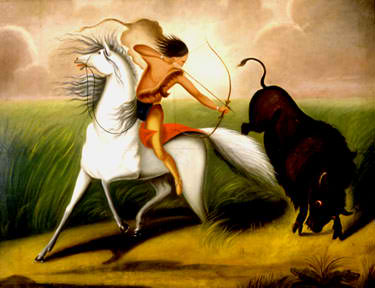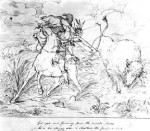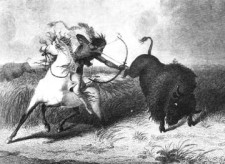


Unknown
American
Buffalo Hunter, 1844 ca.
oil on panel
40 × 51 1/8 in.
SBMA, Gift of Harriet Cowles Hammett Graham in memory of Mr. Buell Hammett
1945.1

RESEARCH PAPER
PROVENANCE
The painting is done in oil, the surface smooth with even paint strokes, but cracked with a horizontal line. The technique is primitive, due to the lack of a three dimensional apperance. The Buffalo Hunter was found by Holger Cahill in Pennsylvania. The records of Downtown Galleries, now in custody of the Archives of American Art, indicate that it was purchased November 17, 1932 from Messrs. Wierman in York Pennsylvania and sold to Mr. Buell Hammett through Dalzell Hatfield November 13, 1939.
Thanks to the Federal Arts Project in the early 30's and 40's America was rediscovering it's own art. People who were interested in the International Modern Art movement also felt an affinity for American Primitive art. Henri Matisse, in 1933, had seen and admired the painting and talked of buying it. It was owned at the time by the Downtown Galleries in New York, and Edith Gregor Halpert refused to sell it to Matisse because she believed it belonged in an American art collection. She also organized the American Folk Art Show which was held in the Faulkner Gallery in the Santa Barbara public Library and that was the first time The Buffalo Hunter came to Santa Barbara.
When Donald Bear, the first Director of the S.B.M.A. saw The Buffalo Hunter, he exclaimed to Buell Hammett who was the founding President of the Museum, that if he had that painting he could develop a great American collection around it. Mr. Hammett bought the painting, and upon his death, Mrs. Hammett generously gave it to the S.B.M.A. This helped inaugurate one of the great American collections in the west.
THE ARTIST
Although the artist is unknown, the influence of two major artists can be seen. George Catlin, illustrator and artist lived among the Indians for eight years, recording their daily lives in his body of work. F.O.C. Darley, a more sophisticated and skillful artist illustrator, never travelled out west, but was greatly influenced by Catlin's work. It was Darley's etching of The Buffalo Hunter reproduced in black and white in 1844 in Grahams Magazine that our artist used as a model for The Buffalo Hunter which now hangs in the S.B.M.A.
The buffalos great size, vast numbers and wide distribution made it one of the largest game species known to mankind. The buffalo was a gregarious animal who lived in small bands of 5 to 50, all sexes and ages. In danger they formed a compact mass, presenting a united front to the enemy with the younger animals in the middle.
The Spanish introduced the horse to North America in the 1600's. During the mid 1600's the Pueblos Indians left their Spanish masters in New Mexico, taking the horses with them, forming wild tribes. Within 120 years the horse culture and all it's complexities had spread throughout the Great plains region. The Indian moved from subsistance living to a great abundance of food and clothes.
The Great Plains were a vast uncharted territory occupied by the buffalo and the Indians who hunted them. But then in 1848 came the discovery of gold and an avalanche of fortune hunters cascaded towards the Sierra Nevada. Along with this human avalanche came disease, which obliterated tribes living close to the overland trail. This mass migration also chased away the buffalo. The west was new and exciting, fostering a great curiosity, and stimulating change, and rebirth. Tragically this rebirth brought death to the buffalo and to his Nemesis the Indian.
THE PAINTING
Some of the earlist American artists were commercial artists who designed signs for store fronts and taverns. The Indian was a popular advertising symbol during the 19th century. Indians were believed to have a providential communal relationship with nature, and this was widely depicted on labels advertising various health tonics. Taverns and Store fronts also used this motif.
Our artist was a Primitive Romantic painter who had no formal training, but a strong sense of design. Our Buffalo Hunter is portrayed in a direct artistic sense. The actual placement of the horse and the buffalo are not accurate in terms of what is seen in a real hunt.
The artist has however expertly conveyed the tense emotion of the scene by the simplicity of the painting. The background of the storm, the agitated, blowing lines of the prairie grass all visually push the Indian, horse and buffalo at you. The moment before the kill, frozen in time make you feel the tautness of the bow, and experience the horror seen in both of the animals eyes. The complimentary colors keep your eye locked on the action and moving around the figures darting from the Indian to the buffalo up to the horses wild look.
Prepared for the Santa Barbara Museum of Art Docent Council by Kathy Doherty March 30, 1988.
No Bibliography available
POSTSCRIPT
The artists who are most directly involved with creating the image in the Santa Barbara Buffalo Hunter are George Catlin and F. O. C. Darley.
CATLIN'S ILLUSTRATIONS
Catlin's illustrations of Indian buffalo hunting were vastly more extensive and comprehensive than anything yet undertaken and released to the general public.
The specific Catlin illustrations involved depict the Sioux Indians and are the following:
Plate 107 (Fig. 1), for which Catlin's text reads,
In plate 107, I have fairly represented the mode of approaching, at the instant the arrow is to be thrown; and the striking disparity between the size of a huge bull of 2000 pounds weight, and the Indian horse, which, it will be borne in mind, is but a pony.
Fig. 1 George Catlin, Illustrations of the Manners, Customs and Conditions of the North American Indians, first published 1841, 1876 edition, plate 107, p. 252. Courtesy of the University of California, Santa Barbara, Library.
Plate 108 (Fig. 2), for which Catlin gives the following text,
...I have represented a party of Indians in chase of a herd some of whom are pursuing with lance and others with bows and arrows. The group in the foreground shows the attitude at the instant after the arrow has been thrown and driven to the heart; the Indian at full speed...
Fig. 2 George Catlin, Illustrations of the Manners, Customs and Conditions of the North American Indians, first published 1841, 1876 edition, plate 108, p. 254. Courtesy of the University of California, Santa Barbara, Library.
Plate 112 (Fig. 3), described by Catlin as follows,
During the season of the year whilst the calves are young; the male seems to stroll about by the side of the dam, as if for the purpose of protecting the young, at which time it is exceedingly hazardous to attack them, as they are sure to turn upon their pursuers....
Fig. 3 George Catlin, Illustrations of the Manners, Customs and Conditions of the North American Indians, first published 1841, 1876 edition, plate 112, p. 255. Courtesy of the University of California, Santa Barbara, Library.
It is this latter, Plate 112; which is most often said to be the source of the Darley image, though Plates 107 and 108 obviously are close to the Darley as well.
F. O. C. DARLEY'S VERSIONS OF THE BUFFALO HUNTER
Darley was the creator of some of the most animated and attractive Indian illustrations. Darley managed to achieve this competence in Indian subjects with remarkably little in the way of direct observation to go on.
… there is no indication that Darley ever traveled west of the Alleghenies - to say nothing of the Mississippi River, he created his Indians in his studio, first in Philadelphia, and later in New York, and still later in his home in Delaware."
Darley is thus typical of a whole class of artist-illustrators of the mid-nineteenth century, and his way of working from pictures by others is also standard.
The Buffalo Hunter image with which we are concerned first appears among drawings of 1842 that Darley undertook for Scenes of Indian Life (Fig. 4). Beneath it are inscribed the lines,
"Red-eyed and foaming, prone the monster falls
As in his shaggy side is sheathed the poisoned barb."
Fig. 4 F. O. C. Darley, Buffalo Hunter, pen drawing in ink on paper. Courtesy of the Beinecke Rare Book and Manuscript Library, Yale University Library.
An examination of the foreground of the Santa Barbara painting, noting the general proportions but especially the little plant at the lower right, which is in the Graham's version but is missing in cropped versions, indicates that the Santa Barbara painter was working directly or indirectly from the Graham's version.'
Fig. 5 F. O. C. Darley, Buffalo Hunt, "engraved expressly for Graham’s Magazine by Cushman from an original drawing by Darley," September, 1844, frontispiece. University of California, Santa Barbara, Library.
EARLY DESCRIPTION OF THE BUFFALO
By Washington Irving, 19th c. American novelist
An important American writer who brought the buffalo vividly to the popular imagination is Washington Irving who, in 1832 actually went west as far as Oklahoma. His A Tour o f the Prairies was published in 1835 and has remained an American classic. He writes of buffalos and of hunting them on several occasions; his descriptions have seldom been bettered. He describes the beast as follows:
There is a mixture of the awful and the comic in the look of these huge animals, as they bear their great bulk forward, with an up and down motion of the unwieldy head and shoulders; their tail cocked up like the queue of Pantaloon in a pantomime, the end whisking about in a fierce yet whimsical style, and their eyes glaring venomously with an expression of fright and fury .... Of all animals, a buffalo, when close pressed by the hunter, has an aspect the most diabolical. His two short black horns curve out of a huge frontlet of shaggy hair; his eyes glow like coals; his mouth is open, his tongue parched and drawn up into a half crescent, his tail is erect, and tufted and whisking about in the air; he is a perfect picture of mingled rage and terror."
THE END OF THE BUFFALO
Any consideration of the depiction of one buffalo hunt must note that the circumstances as Catlin and others knew them, when hundreds of thousands of buffalos thundered over the plains, changes drastically. The orgy of buffalo slaughter, by Indian and White - for meat, for robes, for hides - reached its peak in the mid-1870s. Carcasses lined the lands the new railroads crossed, then bones; finally, a poor living could be made collecting the bones and selling them for $4.00 a ton. By 1887, there were only 400 wild buffalo left, and about the same number in captivity. By 1890, the Frontier was officially closed. Unbelievably, the buffalo was gone from the plains, and the Indians were nearly gone as well.
Later artists who depicted the buffalo - Albert Bierstadt, Walter Shirlow, even Rosa Bonheur, who painted from her sketches of Buffalo Bill's Sideshow in Paris, Charles Russell and Frederick Remington - did so with a nostalgic backward look at a primitive life that was no more.
Our Buffalo Hunter, painted by an unknown "celebrant of a national landscape and mythology," emanated from a happier, more innocent day, which rejoiced in the grace and freedom of the men and the beasts of the American Wilderness.
BIBLIOGRAPHY
All additional information was adapted and copied from:
Santa Barbara Museum of Art, THE BUFFALO HUNTER and other versions of the subject in nineteenth-century art and literature, Paul Chadbourne Mills.
Prepared for the SBMA Docent Council by Loree Gold, 2006.

F. O. C. Darley, Buffalo Hunt, "engraved expressly for Graham’s Magazine by Cushman from an original drawing by Darley," September, 1844, frontispiece. University of California, Santa Barbara, Library.
